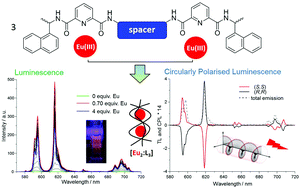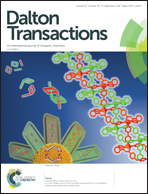The effect of the linker size in C2-symmetrical chiral ligands on the self-assembly formation of luminescent triple-stranded di-metallic Eu(iii) helicates in solution†
Abstract
Chiral lanthanide-based supramolecular structures have gained significant importance in view of their application in imaging, sensing and other functional purposes. We have designed chiral C2-symmetrical ligands (L) based on the use of two 2,6-pyridine-dicarboxylic-amide moieties (pda), that differ from one another by the nature of the diamine spacer groups (from 1,3-phenylenedimethanamine (1(S,S), 2(R,R)) and benzene-1,3-diamine (3(S,S), 4(R,R)) to much bulkier 4,4′-(cyclohexane-1,1-diyl)bis(2,6-dimethylaniline) (5(S,S), 6(R,R))) between these two pda units. The self-assembly between L and Eu(III) ions were investigated in CH3CN solution at low concentration whereby the changes in the absorbance, fluorescence and Eu(III)-centred emission spectra allowed us to model the binding equilibria occurring in the solution to the presence of [Eu:L2], [Eu2:L2], [Eu2:L3] assemblies and reveal their high binding constant values. The self-assembly in solution were also studied at higher concentration by following the changes in the 1H NMR spectra of the ligands upon Eu(III) addition, as well as by using MALDI-MS of the isolated solid state complexes. The chiroptical properties of the ligands were used in order to study the structural changes upon self-assembly between the ligands and Eu(III) ions using circular dichroism (CD) and circularly polarised luminescence (CPL) spectroscopies. The photophysical properties of [Eu2:L3] complexes were evaluated in solution and showed a decrease of luminescence quantum yield when going from the ligand with smaller (1(S,S)) to bulkier (5(S,S)) linker from ∼5.8% to ∼2.6%. While mass-spectrometry revealed the possible formation of trinucler assemblies such as [Eu3:L3] and [Eu3:L2].



 Please wait while we load your content...
Please wait while we load your content...